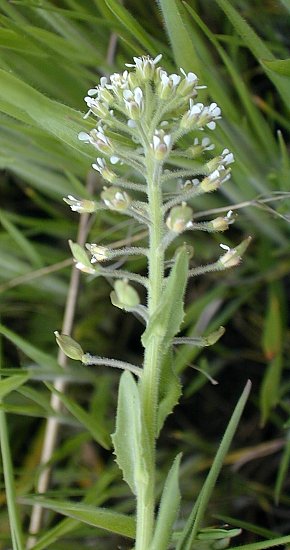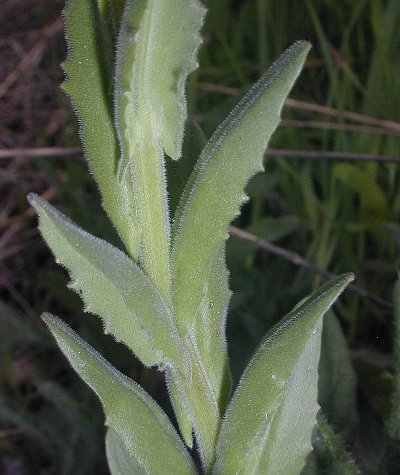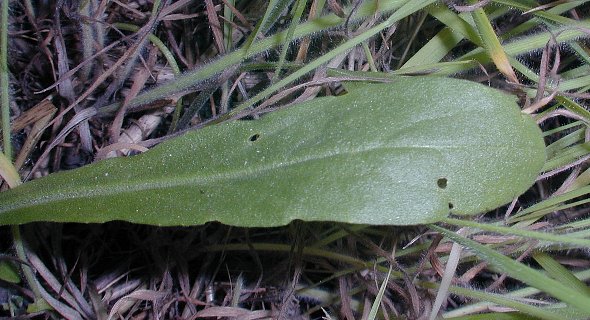Description: This plant is a winter annual that becomes 1-2' tall, branching at the base and near the apex where the flowers occur. Initially, this plant consists of a rosette of basal leaves spanning about ½–¾' across. These basal leaves are narrowly obovate and occasionally pinnatifid toward the base. Their margins are entire or slightly undulate. One or more flowering stems develop from the rosette that are more or less erect. They are greyish green and covered with fine hairs. The cauline leaves are alternate, up to 3" long and ¾" across, becoming smaller as they ascend the stems. They are narrowly sagittate in shape and slightly dentate, entire, or undulate along the margins; each cauline leaf clasps the stem at the base. Both the basal and cauline leaves are greyish green and covered with fine hairs, like the stems.

Each stem
terminates in a raceme of white flowers. The flowers are in bloom
toward the apex of the raceme, while the seedpods (silicles) develop
below. Each flower is about 1/8" (3 mm.) long, consisting of 4 white
petals
and 4 green or purplish green sepals that are lanceolate-oblong. The
pedicels of the flowers are slender, hairy, and spreading. The blooming
period occurs during late spring or early summer and lasts about 1-2
months; some plants may bloom later in the year. Each seedpod is about
¼" long, oval-shaped, somewhat flattened, and conspicuously notched at
its apex. It is divided into 2 cells, each cell containing a single
seed. Each seed is reddish brown or reddish yellow; its flavor is
pungent. The seedpods can be blown about by the wind or float on water.
The root system consists of a stout taproot. This plant spreads by
reseeding itself and occasionally forms colonies.
Cultivation:
This plant is typically found in full sun, mesic to slightly dry
conditions, and a loam or clay loam soil. Sometimes it occurs in dry
gravelly areas, where its size will be smaller.

Range &
Habitat:
Field Peppergrass occurs in most counties of Illinois; it is occasional
to locally common (see Distribution
Map). This plant was accidentally introduced into North
America from Europe. Habitats include cropland, fallow
fields, pastures,
areas along roadsides and railroads, grassy banks, and waste places.
Disturbed areas are preferred.
Faunal Associations:
The flowers of Lepidium spp. attract Syrphid flies
and small bees primarily. Occasionally, various wasps suck nectar from
the flowers. Information about the relationship of Field Peppergrass to
birds and mammals is currently unavailable.
Photographic Location:
Along a roadside bank at the Windsor Road Prairie in Champaign,
Illinois.

Comments: The most striking characteristic of this plant are the fuzzy stems and leaves. Nearly glabrous specimens occur, but they are uncommon. The white flowers are quite small and they occur on rather long hairy pedicels. Field Peppergrass can be distinguished from other Lepidium spp. (Peppergrasses) by its hairy stems and leaves. Other members of this genus, like Lepidium virginicum (Common Peppergrass) and Lepidium densiflorum (Small-Flowered Peppergrass), have stems and leaves that are glabrous, or nearly so. Another species, Cardaria draba (Hoary Cress) is somewhat similar in appearance to Field Peppergrass. However, Hoary Cress has larger flowers, unnotched seedpods, hairless pedicels, and somewhat broader cauline leaves. Another group of plants in the Mustard family, Thlaspi spp. (Pennycresses), have similar racemes of small white flowers, but they have larger seedpods (about 1/3" or 8 mm. long).